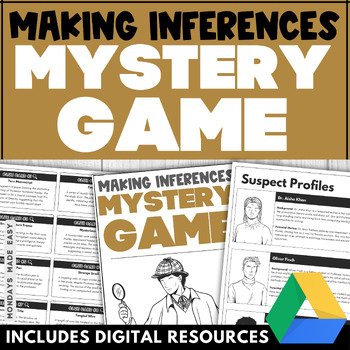Making Inferences Lesson - Solving a Mystery Game - Case of the Lost Manuscript
- Zip
- Google Apps™

What educators are saying
Also included in
- Looking for middle school mini lessons, worksheets, handouts, and activities to teach literacy in the secondary English Language Arts classroom? This MASSIVE bundle includes reading, writing, speaking and listening activities for over 29 weeks of daily lessons, activities and literacy tasks!⚡️⚡️⚡️ OVEPrice $150.00Original Price $349.95Save $199.95
- Make your end of the year activities memorable with these language-based assessments, engaging games, year-end student gifts, and end of the year reflection prompts! These resources are suitable for middle school and high school students and are sure to end your school year on a high note. ⚡️⚡️⚡️ SavePrice $24.00Original Price $32.75Save $8.75
Description
Transform your lesson on making inferences into a thrilling adventure with this solving a mystery game! Students will explore "The Case of the Lost Manuscript" to make inferences and solve the mystery. Suitable for online learning with digital worksheets for Google Classroom®.
Included with this Making Inferences Lesson:
✏️ Investigation Briefing Overview Slideshow - Microsoft PowerPoint®, Google Slides® & PDF
✏️ Investigation Briefing Overview Handout - Digital & Print
✏️ Investigation Clue Cards - Digital & Print
✏️ Evidence Documents - Digital & Print
✏️ Suspect Profiles - Digital & Print
✏️ Plot Development Worksheet - Digital & Print
✏️ Final Presentation Template - Digital & Print
✏️ Editable 4-Level Rubric - Editable & Ready-to-Print
✏️ Teacher Instructions for using this resource
How to use this Solving a Mystery Game:
This activity teaches students critical thinking, inferencing, and problem-solving skills as they analyze clues, evaluate evidence, and draw conclusions to solve the mystery at hand. Students will explore the resources provided in order to develop a presentation outlining which suspect they believe to be guilty of stealing the missing manuscript.
You can begin this lesson with the Investigation Briefing Overview Slideshow. This slideshow lesson introduces “The Case of the Lost Manuscript.” In this case, students will uncover the truth behind the disappearance of a valuable literary treasure and bring the culprit to justice. Students will explore the background information, initial clues, and suspects featured in the slideshow.
To brief your students on the case, you can also provide them with the Investigation Briefing Handout. This handout will give your students a detailed briefing of the background information, key suspects, and initial clues. It also serves as a guide to help students navigate the investigation and stay on track as they uncover the truth behind the mystery.
Challenge your students to analyze evidence found at the crime scene, including torn papers, footprints, and mysterious objects, to uncover hidden clues. The Investigation Clue Cards and Suspect Profiles provided will prompt your students to make inferences to piece together the puzzle.
This resource also includes Evidence Documents to enhance the investigation with records that include witness statements, handwritten notes, and forensic reports. These evidence documents add realism to the activity and provide students with additional clues to analyze and practice making inferences.
Guide your students in organizing their thoughts, tracking progress, and developing theories as they dig deeper into the investigation with the Plot Development Worksheet provided. This worksheet helps students stay organized and focused as they work through the mystery, ensuring that they make logical connections and draw well-supported conclusions.
Once students have explored the suspects, clue cards, and evidence documents provided, they are ready to begin formulating their presentations. They can use the Final Presentation Template provided to outline their presentation. This framework prompts students to communicate their insights effectively and encourages critical thinking skills.
To consolidate this activity, you can lead a reflection session where students can share their thoughts and insights on the investigation process. Encourage them to consider what they learned from the activity and how it relates to real-world inferencing skills.
For assessment purposes, an editable 4-level rubric has also been provided. You can adjust the success criteria to meet the needs of your unique curriculum and individual needs.
For classrooms utilizing Google Classroom®
To access the digital version of these resources, simply follow the instructions within the resource to copy the files directly to your Google Drive®.
✨ Kindly note that due to copyright restrictions, this resource is not editable. This is a common practice within the TPT marketplace in order to protect the clip artists and software providers that have authorized their intellectual property for the development of this resource.
❤️ See what others are saying! ❤️
Tochi M.
May 8, 2024
⭐⭐⭐⭐⭐ Extremely satisfied
This was a great partner project for my students to use to refresh on Inferences. So much fun watching them complete this activity. They got really competitive with it.
Ms. Miller
May 15, 2024
⭐⭐⭐⭐⭐ Extremely satisfied
My students love this activity! It's really helped them make sense of inferring with a more active approach.
⭐ Customer Tip! ⭐
Want FREE CREDIT to go towards purchases? Make sure to offer feedback for your downloads! Follow these instructions below:
- Go to your "My Purchases" page to find a "Provide Feedback" button next to each download.
- Follow this link to offer a quick rating and leave a short comment for the product. Each time you give feedback, TPT gives you feedback credits that you use to lower the cost of your future purchases!
- Your feedback is important to me as it helps me to continually improve my products and ensure they are meeting your needs!
Follow me! Be the first to know about product launches, sales, discounts, and free giveaways:
➾ The Blog
For questions, collaborations, or other concerns:
✉ Contact me: hello@mondaysmadeeasy.com
Access my Free Resource Library!
Mondays Made Easy is committed to the continual improvement of resources to meet the current needs of teachers. This product was last updated on May 03, 2024.







